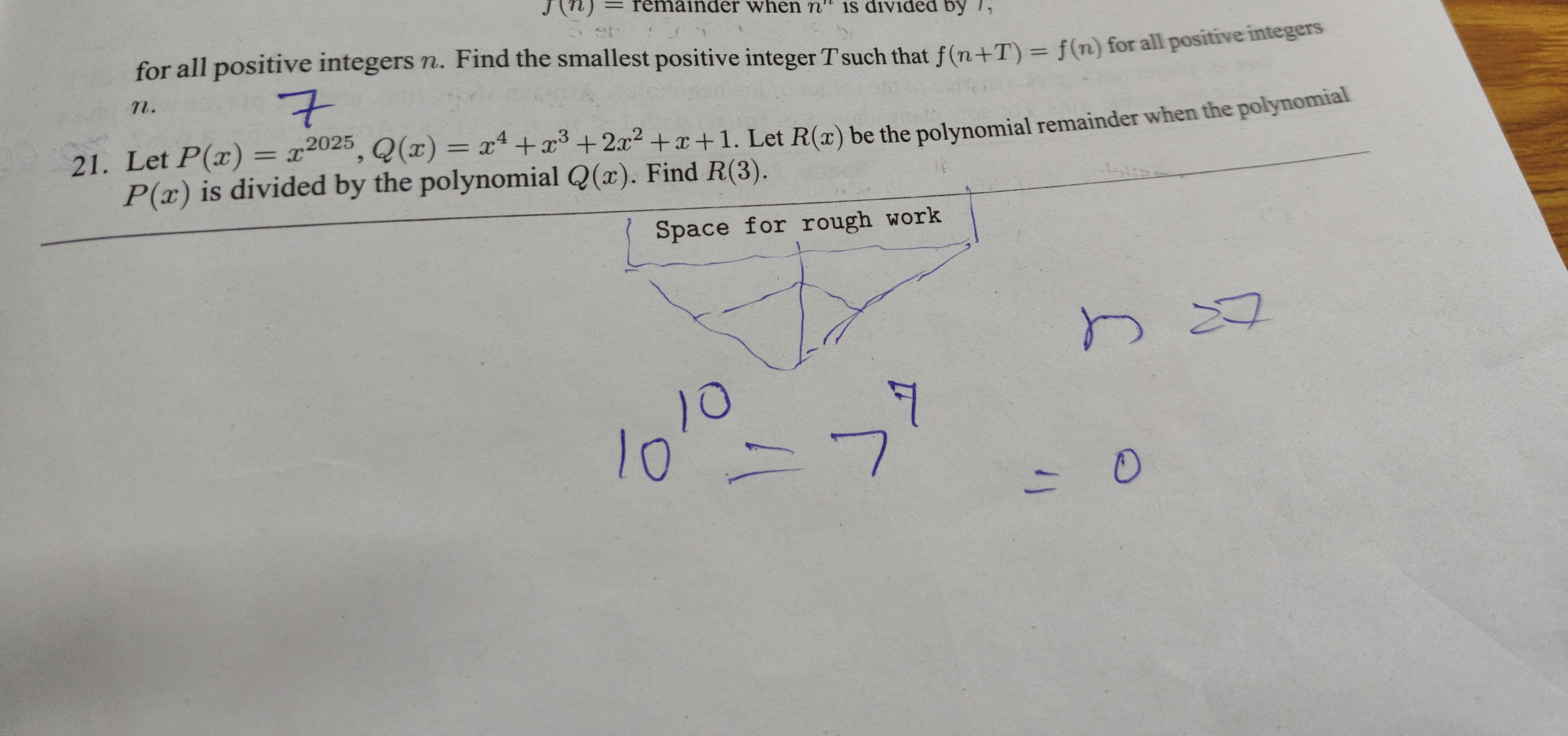Question
Question: Let $P(x) = x^{2025}$ and $Q(x) = x^4 + x^3 + 2x^2 + x + 1$. Let $R(x)$ be the polynomial remainder ...
Let P(x)=x2025 and Q(x)=x4+x3+2x2+x+1. Let R(x) be the polynomial remainder when the polynomial P(x) is divided by the polynomial Q(x). Find R(3).

21
53
7
1
53
Solution
We are given P(x)=x2025 and Q(x)=x4+x3+2x2+x+1. We need to find the remainder R(x) when P(x) is divided by Q(x), and then evaluate R(3).
First, let's factorize Q(x): Q(x)=x4+x3+2x2+x+1 We can group terms: Q(x)=x2(x2+x+1)+(x2+x+1) Q(x)=(x2+1)(x2+x+1)
The roots of Q(x) are the roots of x2+1=0 and x2+x+1=0.
Case 1: Roots of x2+x+1=0. Let ω be a root. Then ω2+ω+1=0. Multiplying by (ω−1), we get ω3−1=0, which means ω3=1. If x is a root of Q(x), then P(x)=R(x). So, R(x)=x2025. Since ω3=1, we can reduce the exponent 2025 modulo 3. 2025÷3=675 with a remainder of 0. So, ω2025=(ω3)675=1675=1. Thus, for any root x of x2+x+1=0, R(x)=1. This implies R(x)≡1(modx2+x+1).
Case 2: Roots of x2+1=0. Let i be a root. Then i2+1=0, so i2=−1. The powers of i cycle with a period of 4: i1=i,i2=−1,i3=−i,i4=1. We need to reduce the exponent 2025 modulo 4. 2025÷4=506 with a remainder of 1. So, i2025=i4×506+1=(i4)506⋅i1=1506⋅i=i. Thus, for any root x of x2+1=0, R(x)=x. This implies R(x)≡x(modx2+1).
Now we have two congruences for R(x):
- R(x)≡1(modx2+x+1)
- R(x)≡x(modx2+1)
Since deg(Q(x))=4, the remainder R(x) has a degree of at most 3. Let R(x)=ax3+bx2+cx+d.
From R(x)≡1(modx2+x+1), we can write R(x)=A(x)(x2+x+1)+1. Since deg(R(x))≤3, A(x) must be a linear polynomial, say mx+n. R(x)=(mx+n)(x2+x+1)+1=mx3+mx2+mx+nx2+nx+n+1=mx3+(m+n)x2+(m+n)x+(n+1).
From R(x)≡x(modx2+1), we can write R(x)=B(x)(x2+1)+x. Since deg(R(x))≤3, B(x) must be a linear polynomial, say px+q. R(x)=(px+q)(x2+1)+x=px3+px+qx2+q+x=px3+qx2+(p+1)x+q.
Equating the two expressions for R(x): mx3+(m+n)x2+(m+n)x+(n+1)=px3+qx2+(p+1)x+q
Comparing coefficients:
- m=p
- m+n=q
- m+n=p+1
- n+1=q
From (2) and (4), we have m+n=n+1, which implies m=1. Since m=p from (1), we have p=1. Substitute m=1 into (2): 1+n=q. This is consistent with (4). Substitute m=1 into (3): 1+n=p+1. Since p=1, this becomes 1+n=1+1, so 1+n=2, which gives n=1. Now we find q using q=n+1: q=1+1=2.
So, m=1,n=1,p=1,q=2.
Substitute these values back into the expressions for R(x): Using the first form: R(x)=1x3+(1+1)x2+(1+1)x+(1+1)=x3+2x2+2x+2. Using the second form: R(x)=1x3+2x2+(1+1)x+2=x3+2x2+2x+2. Both forms yield the same remainder R(x)=x3+2x2+2x+2.
Finally, we need to find R(3): R(3)=(3)3+2(3)2+2(3)+2 R(3)=27+2(9)+6+2 R(3)=27+18+6+2 R(3)=53.
The first part of the question regarding f(n) and T is incomplete and cannot be solved. The number 7 is likely an answer to that part. We have solved problem 21.
